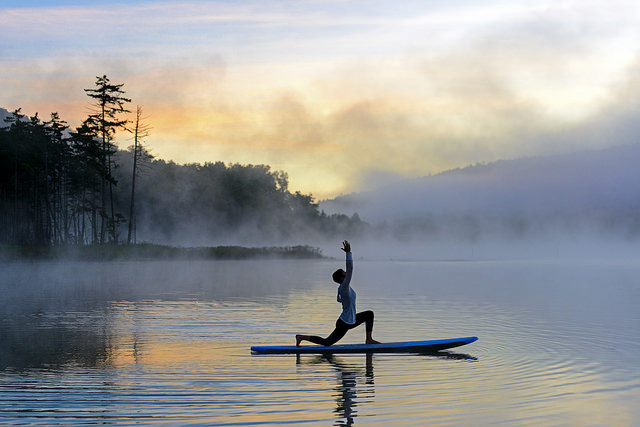
One of the first things I learned about yoga was how vital it is to feel the ground beneath your feet.
So the first time I attempted a downward facing dog pose while teetering precariously on a stand-up paddleboard (SUP), I was pretty sure I’d lost my mind. Why the heck would someone practice yoga on the water?
7 Reasons to Find Your SUP Yoga Groove
1. Water rules
Water covers more than 70 percent of the surface of the earth, and up to 60 percent of our bodies are comprised of water, but about 64 percent of the population is afraid of open water.
As I moved painstakingly slowly into that first pose I quickly reminded myself that our first environment is the life-giving liquid of amniotic fluid, so some part of me felt right at home in that floating down dog.
2. Water encourages embracing rather than avoiding
The practice of yoga encourages us to move towards things we might rather move away from. It invites us to become curious about the places where we tense up, both in our bodies as well as in relationships and life situations. SUP Yoga is a wonderful invitation to move, in a healthy way, towards these things.
SUP Yoga is a great practice for many, like me, who tend to get into the habit of putting my yoga mat in the same place for the same yoga classes, to become aware of the things that we do in attempt to create an external sense of stability.
[Related: Know What’s SUP: 6 Tips For Your First SUP Yoga Class]
After all, why do I want a yoga practice that’s only good when things are stable?
3. Practicing yoga on the water spotlights our instabilities; when we become aware and curious about these, we can create more balance
I find that being on the water, and the instability of practicing yoga on the board, highlights the areas in which I have instabilities and asymmetry.
For example, when practicing Downward-Facing Dog pose on my stand up paddleboard, I am acutely aware that I place more weight into my right hand, which causes the left side of my board to pop up. If I tense up, it furthers the instability of my balance on the board, but when I breathe and relax, I can tune into these nuances and stabilize.
4. Water invites fluidity
In SUP Yoga, we’re asking people to trust, not to tense up, create balance out of releasing rather than clinging.
On the paddleboard, this is most evident in our toes. The most common rookie mistake is toe crunching. When the water and waves move beneath our boards, there’s a tendency for our toes to tense up and try to grip the board. The yogic practice, especially on water, is invitation to align the placement and movement of our bodies with the fluidity of water.
The movement of water is much like the movement of our breath.
5. Yoga emulates nature
The postures (asanas) are reflections of the natural world, such as Tree, Cobra, Pigeon, and salutations to the Sun. When we align our bodies into these shapes in the midst of nature, rather than indoors, we have a deeper opportunity to experience a sense of interconnectedness. The root of the Sanskrit word “yoga” is “yuj” which translates to mean “union.”
For the last eight years that I’ve been teaching yoga, I’ve consistently said to students, “We really should be practicing outdoors, in nature.” I love to practice tree pose in a tree, boat pose on a boat… you get the idea.
6. Water provides a reprieve from overstimulation
SUP Yoga invites a much needed break from technology (no phones/emails). Even though Groupon has featured waterproof smartphone cases, who wants to risk drowning their $300 phone?
In the multitudes of research used for health and wellness education, as noted by businessandtechnology.eu, there seems to be an underlying and unifying theme: over-stimulation. With the increasing dependence on technology, people are required to do less physical activity, at the same time increasing mental activity. While often useful, if not managed carefully, this can manifest in poor health.
7. Practicing on the water is, well, practical
If I only have a practice that is useful when things are stable and contained, is that a very useful practice?
As we in SUP Yoga class takes the shape of Savasana, I trail my fingertips in the cool water and close my eyes. I feel the rippling waves from a far away speedboat, lapping under my board, I recognize that if I only know how to mediate when things are smooth, I’m kinda screwed.
Whatever the reasons are that people show up to take a SUP Yoga class (to deepen an existing yoga practice, to try both yoga and paddling for the first time) I always hope that the ground feels different after they’ve practiced on the water.
– See more at: http://yoganonymous.com/7-reasons-to-find-your-sup-yoga-groove#sthash.kVffjhDl.dpuf
